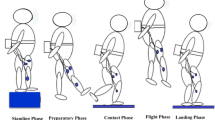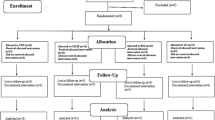Abstract
Jumping ability and explosive power are crucial to basketball players. The purpose of this study is to examine the effects of a four week plyometric training on basketball players’ jumping ability and explosiveness. The testing aspects include single-leg and two-leg vertical jump height, 40-m dash, 10-m dash, as well as the anaerobic power test. The participants were 17 healthy male CUBA (Chinese University Basketball Association) basketball players, aging at 18–24. All participants were tested both before and after the four week training. The outcome showed that there were big differences existing in the statistics of anaerobic power and jumping height: the anaerobic peak power reached the level of significance at (p = 0 0.02), relative power at (p = 0.046), left leg vertical jump height at (p = 0), right leg vertical jump height at (p = 0.046). These show that the four week plyometric training can improve single-leg vertical jumping ability and overall power endurance ability. However, it does not greatly improve the athletes’ sprinting ability in 40-m dash, 10-m dash as well as their two-leg vertical jumping ability.
Access provided by Autonomous University of Puebla. Download conference paper PDF
Similar content being viewed by others
Keywords
1 Introduction
Plyometrics is the contraction of muscles, it is also known as a method of training muscle elastic strength and explosiveness to improve and enhance athletic performances [1]. Scholars in Hong Kong and Tai Wan translated it into muscle strength training [2]. Strength training is based on muscular contraction. These fast and powerful movements of contraction will stimulate stretch–shortening cycle. Training in which the concentric contraction of muscle occurs and then followed by an eccentric contraction can be called Plyometric Training. There are three mechanical models: (1) Mechanism of muscle elasticity. (2) Stretch reflex process. In the muscle strengthen training, muscle concentric contraction happens, when muscle lengthens, muscle spindle is stretched due to stimulation, then stretch reflex happens. (3) Working of neuromuscular system. No matter how strong the muscle is, the nervous system will play a role in plyometric training, when a muscle is stretched, the neuromuscular system starts to work, it will detect it and give it a protective response, which means that the neuromuscular system will control the movements to a proper rate, and make the muscle movements more effective [3].
Basketball demands good physical fitness in athletes, especially focusing on their jumping and sprinting ability, this can be proved from certain movements in basket ball such as pass on and go, power drive/stop, standing jump and reach, block etc. All these moves are quite challenging in terms of explosiveness and jumping ability. And the muscle moves are concentric contraction followed by eccentric contraction, which are same as the moves in plyometric training. Plyometric training has been popular for many years, but the study of its effects on CUBA players of China is rare. This paper aims at analyzing the effects of plyometric training on jumping ability and explosive power of male CUBA basketball players, the main purpose is to further benefit basketball training for CUBA players by improving their jumping ability as well as explosive power.
2 Participants
Participants are 19 players from one of the CUBA group A basketball teams, 17 out of 19 players finished the whole training and test, listed below are their basic information (Table 55.1):
2.1 Documentation Method
In order to get a basic theoretical idea of plyometric training, reading documentary information related to plyometric training is the first studying step.
2.2 Experiment Method
2.2.1 Basic Structure of Experiment
A four week plyometric training was given to participants during their off-season period, the training included three sessions (one hour for each session) per week, altogether there are twelve sessions. The session combined 10 min warm-up exercise, 40 min basic exercise then followed by 10 min relax exercise. There were 3 min break among exercises, and there were also 2 min break in the same exercise. These exercises in training program were based on the advices of Dr. Donald Chu’s “Jumping into Plyometric” idea [4] (Table 55.2).
2.2.2 Testing Procedure
Every participant was tested before and after the training. Testing place was in Sports Science Research Institute and the track and field venue. Testing order of the participants was random. The test was finished in a day. The last test was given three days after the final training. We used “Taina” height weight scale for height and wight measurement, and analyzed body composition by using body composition analyzer made by company of China Sports and Tongfang.
In 40-m dash, participants were asked to perform one by one. Stopwatches were allocated at 10 and 40-m points, as the participants’ performing averages would be recorded. Monark ergomedic 894 E peak bike was used for anaerobic power test. The computer would calculate all the figures and show the index of anaerobic peak power (W), anaerobic relative power (W/kg), and anaerobic minimum power (W) (Table 55.3).
2.3 Statistical Processing
SPSS13.0 was applied for statistical processing. Averages, variance, and significance level were got from paired T test. The independent variable was plyometric training program itself. Variables were single-leg vertical jumping height (cm), two-leg vertical jumping height (cm), 40-m dash time (s), 10-m dash time(s), the anaerobic peak power, anaerobic relative peak power, anaerobic minimum power. We found that the figure of significance level was P < 0.05 (Figs. 55.1, 55.2, 55.3).
2.4 Outcome
17 out of 19 participants finished the whole tests. Tests held both before and after the training were very successful. The charts above were descriptions of the outcomes of related measurements for participants. From chart 3, we can find the differences before and after training. The significance level in two-leg vertical jumping height and 40-m dash time was p > 0.05, but it was p < 0.05 in single-leg vertical jumping height, anaerobic peak power and anaerobic relative peak power test.
2.5 Analysis and Discussion
The outcome shows that CUBA players’ four aspects have been improved after the training: the figure for single-leg vertical jump height—from (49.5 ± 5.3 cm and 52.6 ± 5.9 cm) to (52.6 ± 5.9 cm and 55.9 ± 6.4 cm); for anaerobic peak power—from (1111.85 ± 139.02 W) to (1165.23 ± 126.34 W); for anaerobic relative peak power—from (13.09 ± 1.67 W/kg) to (13.45 ± 1.49 W/kg). Paired T test shows the figure of significant difference level is (p < 0.05) Based on stretch–shortening cycle (SSC) theory, the results has been improved. According to SSC theory, there are three periods: (1) eccentric contraction periods. (2) Coupling period. (3) Concentric contraction period. In concentric contraction, muscle produces more power due to the process of storing and releasing energy, which means that neuromuscular system plays a role in controlling. However, the outcome cannot prove the improvement that plyometric training may bring to two-leg vertical jump height [5], 10-m and 40-m dash. This outcome did not agree with Rimmer [6] and Brophey’s [7] studies. In their studies, they claimed that participants’ performances in 10-m and 40-m dash can be improved with eight week plyometric training. Thus, it showed that four week plyometric training is not enough to improve players sprinting ability, more time in training is needed. The outcome of two-leg vertical jump height experiment agreed with the study of Luebbers [8]. In Luebbers’s study, participants were university students fancying sports, a four week plyometric training was given, showing that the two-leg vertical height figure went down—from (67.8 ± 7.9 cm) to (65.4 ± 7.8 cm), but when they were tested again after a four week rest, the figure raised to (69.7 ± 7.6 cm). But there were no significant changes in anaerobic power test. So this showed that plyometric training can improve players jumping ability, the evidence may not be found immediately after the training; instead, it may occur after a period of rest. In Polhemius’ study, the participants were university students majoring in sports [9]. They were given basic physical training companied with plyometric training (6 weeks training with 3 sessions per week), the outcome showed that the performance jumping and 40-m dash became worse, which did not agree with this study. This difference in outcome may due to different training arrangement and training intensity. So, all these findings remind us that in order to get the expected results, we need to adjust some exercises and their intensity when doing plyometric training.
In conclusion, the ploymetric training is an effective way to improve CUBA basketball players’ jumping ability and explosive power. The outcome proves that the four week training with three sessions per week can improve players’ single-leg vertical jump height and leg anaerobic power. However, to improve 10-m dash, 40 m dash and two feet jumping ability, this four week training is not enough. The suggestions are to increase training time and add physiological and biochemical index test. Besides, basic physical power training should be added before plyometric training, as in many exercises body power endurance should be 20 times higher than its own weight. Thus, in order to handle the power, players need to become very strong to avoid injury.
References
Michael Yessis, Fred Hatfield Plyometric training (2003) Achieving explosive power in sports. Human Kinetics , Champaign pp 19–29
Chang Hui-yin, Lin Peo-Cheng (2005) The effect of plyometric training for jumping performance in high-school female basketball players. Taiwan Sports J 05:11–18
Lin Z-C (2002) Sports science and training 3rd edn. Yinhe Culture Industry Company, Taibei 02:01–04
Chu DA (1998) Jumping into plyometrics, 2nd edn. Human Kinetics, Champaign 10:270–277
Cavanagh PR, Komi PV (1979) Electromechanical delay in human skeletal muscle under concentric and eccentric contractions. Eur J Appl Physiol 42(3):159–163
Rimmer E, Sleiver G (2000) Effects of a plyometrics intervention program on sprint performance. J Strength Cond 14:295–301
Brophey Patrick (2004) Kelly L. Lockwood. The Effect of a plyometrics program intervention on skating speed in junior hockey players. The Sport Journal 7:10–17
Luebbers Paul E et al (2003) Effects of plyometric training and recovery on vertical jump performance and anaerobic power. J Strength Cond Res 17:704–710
Mai-jiu T (2006) Sports training science Beijing. High Education Press 06:10–18
Author information
Authors and Affiliations
Corresponding author
Editor information
Editors and Affiliations
Rights and permissions
Copyright information
© 2013 Springer-Verlag London
About this paper
Cite this paper
Zhang, X. (2013). Research of Jumping Ability and Explosive Power Based on Plyometric Training. In: Du, W. (eds) Informatics and Management Science III. Lecture Notes in Electrical Engineering, vol 206. Springer, London. https://doi.org/10.1007/978-1-4471-4790-9_55
Download citation
DOI: https://doi.org/10.1007/978-1-4471-4790-9_55
Published:
Publisher Name: Springer, London
Print ISBN: 978-1-4471-4789-3
Online ISBN: 978-1-4471-4790-9
eBook Packages: EngineeringEngineering (R0)







